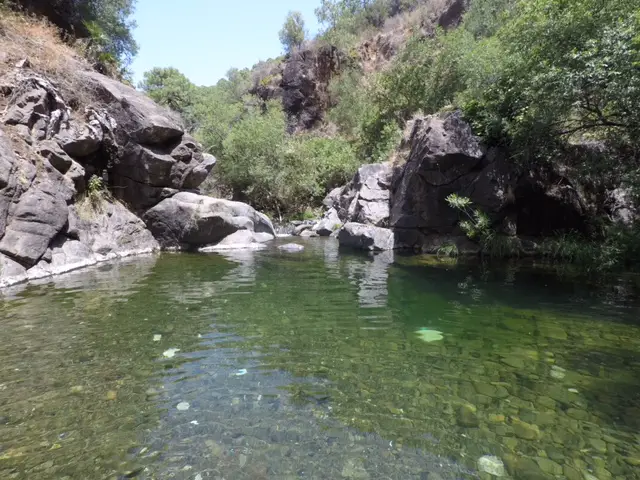Dear reader,
As promised, and as we have already mentioned in other posts, today we are going to give you options for soaking when you can’t go to the beach. You already know (and if I don’t tell you) that, despite our fabulous 22 kilometers of beach, we will not always be able to enjoy them.
Main reasons that prevent us from enjoying the beach in Estepona:
1. Jellyfish
Pollution, warming waters and overfishing are causing these stinging creatures to visit us more than we would like. You will know if there are jellyfish on the beach because the flag indicating their presence will be waving.
A jellyfish sting can ruin your day at the beach. If that happens, go to the nearest aid station and they will help you relieve the pain. However, if you have foresight, my advice is to consult this application so you know what to expect when you go to the beach.
2. Seaweed
These don’t sting, but if you’re one of those who dislike finding floating things, you won’t be able to enjoy the day either. We have been suffering from a plague of Asian algae for years. I wish the only problem it caused was the deterioration of our beaches, but unfortunately it is seriously damaging the marine ecosystem of the Mediterranean.
3. East or West wind
That’s right, depending on the wind blowing, you can go to the beach or not. But in esteponeros.com you have a post where we explain how to know which wind is good and which is bad. This one is not to be missed!
Please let us know if you have any other questions. We are here to help you.
The rivers of Estepona
Before I tell you what to do when the heat gets too hot and going to the beach is not feasible, I am going to tell you a little bit about the rivers of our town. Due to the geological characteristics of Sierra Bermeja and the impermeable nature of its rocks, the peridotites, our municipality has a lot of surface water resulting in a large number of small rivers and streams.
In the areas located at higher altitudes, it favors the appearance of large waterfalls and cascades that are activated in the rainiest months, which unfortunately are less frequent every year. The altitude of Sierra Bermeja and its proximity to the sea, make the streams are short and low flow, yes, if we have a good storm, you will see how they become brave and torrential, so do not trust.
From west to east these are some of the rivers of this municipality, many of them protected due to their environmental importance, in many cases by the Natura 2000 Network as Special Areas of Conservation (SAC):
- Arroyo Vaquero
- Arroyo En medio
- Arroyo del infierno
- Arroyo de Guadalobón
- Arroyo Pantoja
- Río Monterroso
- Río Calancha- Calanchilla
- Río de la Cala
- Arroyo Abrón
- Río Padrón
- Río Castor
- Río Velerín
- Río Guadalmansa
Although Estepona has a Mediterranean heart, its soul is Atlantic, that added to our peculiar mountain, makes its rainfall regime allows most of these rivers retain flow even during the summer, although the intense use of water for irrigation makes its lower sections are dry most of the year.
Well, let’s get down to business…
These are the 7 best ponds in Estepona and surroundings.
1- LA CHARCA DE LAS NUTRIAS (THE OTTER POND)
These are one of the most outstanding and well known pools of this Costa del Sol municipality. The Castor river, protected at European level among other things, for the quality of its waters and the special inhabitant of the same, the otter, is responsible for giving us these natural pools to enjoy in the hot days of the west.
HOW DO WE ACCESS THE OTTER POND(CHARCA DE LAS NUTRIAS?
Tomaremos la salida 160 de la CN-340 para coger el camino de la Alberdina, que es un camino asfaltado, con una zona final de camino de tierra, que lleva hasta una zona de aparcamientos en la a la entrada del Parque Cultural Camino del Castor.
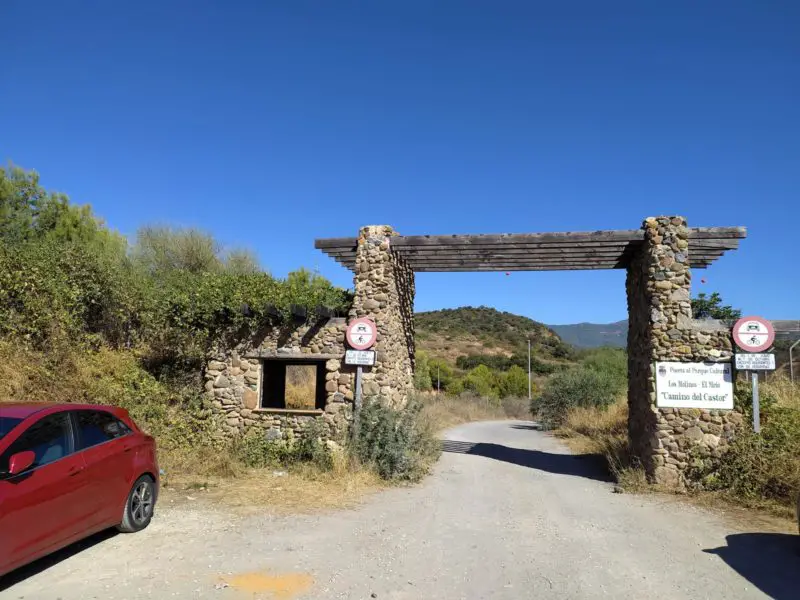
Please note that the pond area is not accessible by car due to the risk of fire. Therefore, you will have to travel about 3 km to reach the riverbed. I recommend, therefore, that you do not do it in very hot hours, because although the road is quite comfortable without many slopes, if you go with children the heat can play a trick on you.
Another option is to leave your vehicle at the Castor service station, for this you will have to take the AP-7 freeway towards Malaga. The disadvantage is that on the way back you will have to pay the toll, and believe me, in summer on the Costa del Sol the highway becomes a luxury item.
At the end of the road we will find a gate that gives access to a private estate. We will take the path that goes off to the right to reach the riverbed.

At about 500 meters we will find the first pool where we will take our first dip. Once recovered from the effort of the road, we will continue upstream among waterfalls, tadpoles and amphibians to reach the Poza del Peñón and a few meters we will enjoy the crystal clear waters of the “Charco Rectangular”, which will make us enjoy its small waterfall.
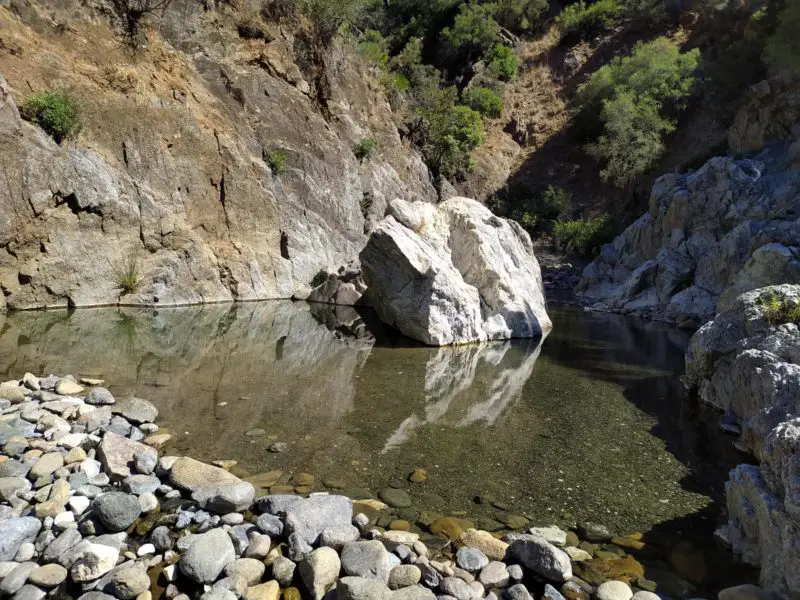
And now comes the best part, the most spectacular and well known of the pools of the Río del Castor: the Charca de las Nutrias. Whether you want to continue investigating and climbing along the riverbed or not, it’s time to take a refreshing swim and enjoy the wonders that nature has to offer.
2- CHARCA DE LA EXTRANJERA
Now it is time to enjoy another of Estepona’s most important rivers: the Padrón River. Here we can enjoy another natural space where we can cool off from the summer heat: the Charca de la Extranjera (Foreigner’s Pond). This pond is accessible by car so you can go with the youngest members of the family without any problem.
HOW DO WE ACCESS LA CHARCA DE LA EXTRANJERA?
Take the Mediterranean Highway (A-7) taking exit 1065 towards the Escuela de Arte Ecuestre de Estepona, towards Algeciras. Once we have taken the exit, we will take the Montesol road, which runs parallel to the Río Padrón. We will have to continue along the same road for about 6 km. After this route, the lane becomes dirt and a branch descends to the riverbank. A few meters ahead we will find an esplanade where we can leave the car.
We will take the riverbed in the direction of its source and after approximately 300 meters we will find the Charca de la Extranjera. This route is faced with little difficulty, it does not cover the water at any time, and with some skill you can move forward jumping from stone to stone playing at being a frog.
We will be surprised by the rocky environment and its green waters. However, do not expect a pond of large dimensions, because in addition to being medium-sized, the water only covers the central area. If you’re going to jump make sure the winter rains haven’t put any malicious rocks on the bottom that will sour your day’s soaking.
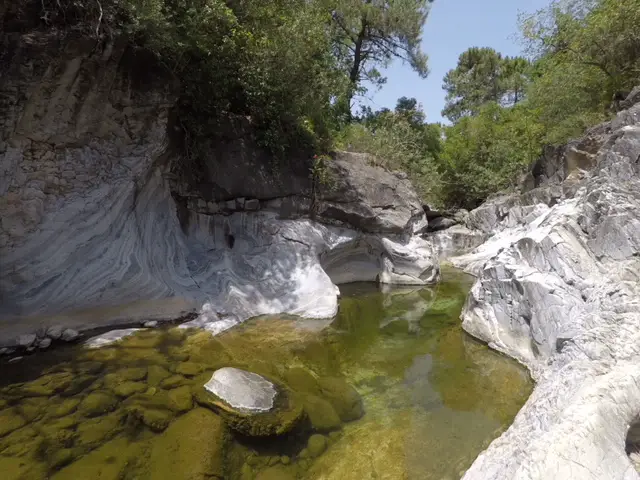
3- CHARCA ARROYO DEL INFIERNO
To find this stream that creates small but refreshing pools that can be an adventure for the family, we will have to take the Camino de Casares towards the Parque de los Pedregales. Once there, we will continue by car until we pass the Dolmens of Corominas and on the left we will find the road that takes us to the stream. The canyon of the Arroyo del Infierno, will give us different ponds with small waterfalls, although we are in the middle of August.
When the road ends, park the car and the adventure begins. So adventurous is it that from here on there will be no route to follow. El caminThe path is marked by the riverbed itself, so fearlessly and bravely follow the course towards the mountain.o lo marca el propio cauce del rio, así que sin miedo y con valentía sigue el curso dirección hacia la montaña. It is a path with stones, which although it is true that it is not a comfortable path, its difficulty is quite affordable.

If after taking a swim and getting tired of climbing up and down rocks you still want more plans, here is what the Parque de los Pedregales has to offer you.
PONDS NEAR ESTEPONA
If these three proposals are not enough for you because the beach is not your thing, we give you other alternatives close to Estepona.
4- BAÑOS DE LA HEDIONDA
Located in the neighboring village of Casares, about 22 minutes from Estepona, you will find an authentic natural and historical wonder. These are sulfur baths. Yes, don’t be scared when you arrive: they smell like “real rotten eggs”. Its origin has many legends that try to explain its existence, from magical legends that claim that the smell of sulfur is due to the last breath of the devil to be expelled from the earth, to the most popular that says that in the year 61 BC Roman troops were resting in that area, preparing to enter into battle with Pompey’s troops and finding themselves infected with scabies, they found healing in its waters. It is even said that Julius Caesar himself was cured of herpes and had the baths built, which are still preserved today.
What is clear and what history, real or not, shows us is that the waters of the Baños de la Hedionda have healing properties for the skin. Although the beginnings of the spa were Roman, it was the Arabs who, through their remodeling, made it possible to maintain the flow regardless of the time of year. In addition, as of 2016 these baths have natural pools to enjoy the environment even more.
In order not to miss this wonder of nature and also to have a good mud bath that will leave you with the complexion of an old-timer, you must make a reservation that will allow you access to the baths during rush hour, established from 12:00 to 19:00 from July 2 to September 9.

5- CHARCA DE LA PALOMA AND CHARCA DEL INFIERNO
If once we have visited the baths we are left wanting more, nearby you have the Charca de la Paloma and del Infierno, approximately 1.5 km away, bathed by the waters of the Manilva River and about 25 minutes from Estepona. It is likely due to the scarcity of rain and the bad use of it that in the middle of summer you will find little water in them, but the scenery is sensational.
Once we have parked the car in the place enabled for the Baños de la Hedionda, we continue parallel to the Manilva river along the route of the PR-A 162 (Ruta de los Molinos Casares-Manilva). When the trail turns to the right, we will continue along the riverbed to first find the beautiful Charco de la Paloma, unmistakable for its beautiful ditch carved into the rocky wall.
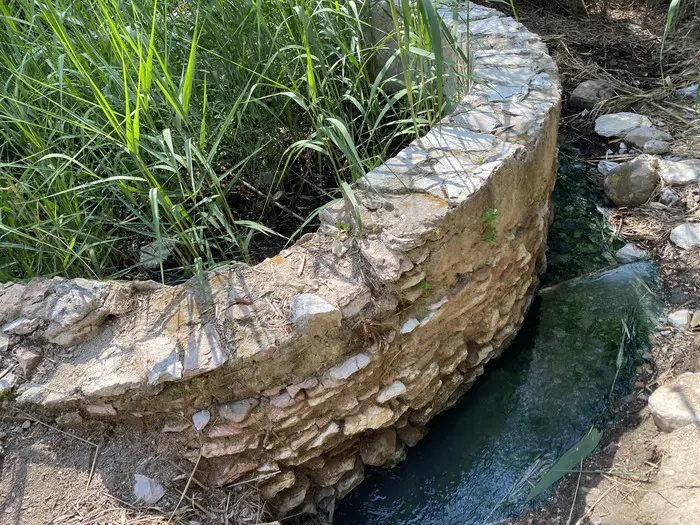
About 100 meters further up, where the path gets a little more complicated and we will have to play the climbers, avoiding numerous stone blocks, we find our next objective: the Charco del Infierno (Hell Pool).
They are not very deep pools, so avoid jumping in if you don’t want to ruin the rest of the summer!

6- CHARCO REDONDO
We are now moving to the neighboring village of Jubrique located about 55 minutes from Estepona. It is a more than recommendable route. Located between Algatocín and Jubrique, the Genal River offers numerous ponds along its course. Among them, the most popular is the one known as Charco Redondo, an authentic inland beach.
Its access is very convenient, since it is located a few steps away from the Puente de San Juan. Nearby is the inn with the same name as the bridge, in case we feel like having a snack after the bath. There are also two nearby campsites in case we are suddenly caught at night and want a different plan. It is a very busy place in the summer season where you will have to be lucky to be able to leave your car.
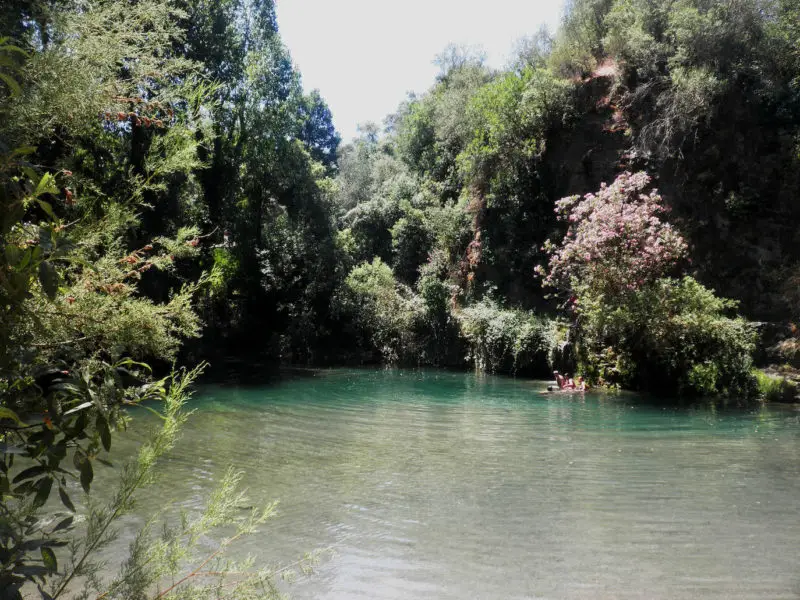
If you are one of those who prefer tranquility upstream, the Charco Estrecho awaits you, smaller in size, but ideal for a swim in a less crowded place.
7- CHARCA DE LAS MOZAS
Benahavís surprises us with the narrows of the Guadalmina River, giving rise to the Charca de las Mozas, one of the most popular of the Costa del Sol and only 22 minutes drive from Estepona.
It has easy access through the Benahavís road, the A-7175, at Km 6.2. The easiest way is to park the car in the village, in the lower area, and go along the side path until you turn off onto a dirt road that will take you to the pool. But if what you want is to enjoy nature and a short walk of 1.5 km, leave your vehicle at the hermitage of Nuestra Señora del Rosario and continue along the fabulous Angosturas trail, which runs parallel to the river and next to the road.
This pool is quite deep so you can enjoy the jumps you want, always taking extreme precautions. We guarantee a spectacular day with family or friends.
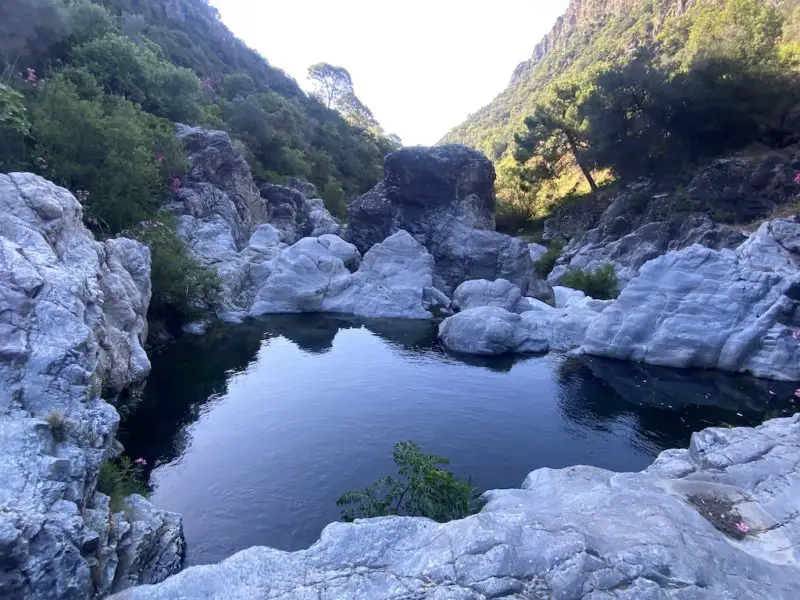
I hope, dear reader, that you enjoy the wonders that nature offers us, always under the prism of respect, the illusion of childhood and the desire to live that summer gives us! I say goodbye with a phrase from Hermann Hesse: “In silence they listened to the whisper of the water, which for them was no longer the current, but the voice of life, of existence, of what will always be”.

